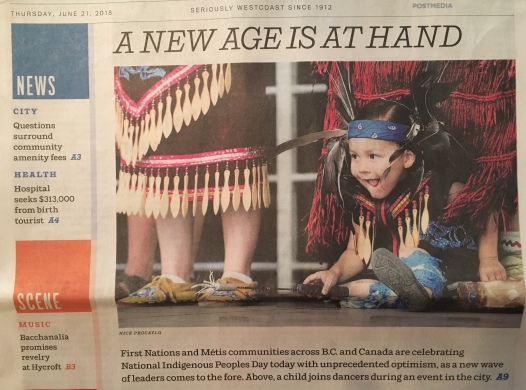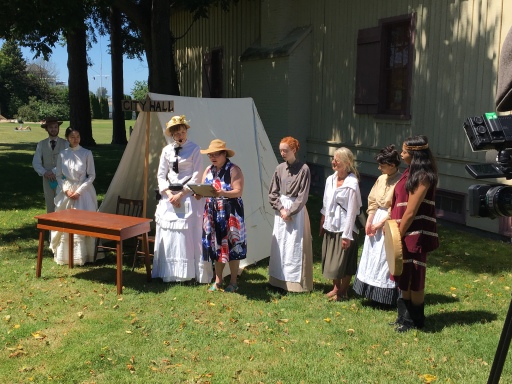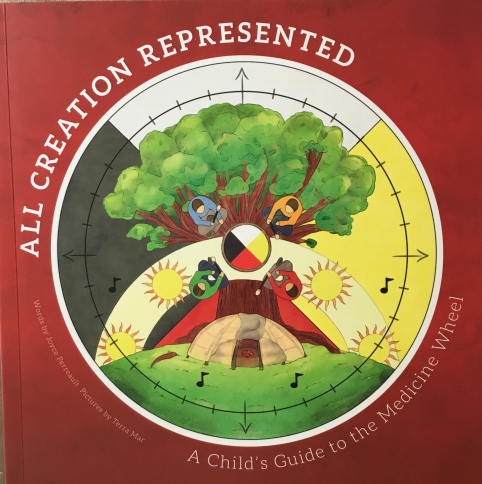
I love the picture of this little guy on the front page of The Vancouver Sun. The sparkle in his eyes and the look on his face remind me so much of my son at that age. With life comes the opportunity for grand adventure! Joy is suppose to be part of every child’s life. I hope that all things good unfold for this little man. The title of the Vancouver Sun picture: “A New Age is At Hand”. Colonialism did not work for the Indigenous people of Canada. But there is hope and there is unprecedented optimism for the future.
A fierce pride in Canada’s accomplishments throughout its almost, 151 years of nationhood, is strong. The is a realization that north of the 49th parallel existed for thousands of years prior to confederation. The learning from the Indigenous people was invaluable. Finally it is part of the national conversation. Within the field of Education in British Columbia, there is a quest to embrace our history, even when it includes the shame of colonial structures and prejudice that allowed children to be separated from their parents and basic human rights to be ignored.
Summer solstice, the longest day of the year, was chosen to be THE day to celebrate, recognize and honour the heritage, cultures and valuable contributions by the First Nations, Inuit and Metis peoples of Canada. The Northwest Territories has celebrated this day as a statutory holiday since 2001 and The Yukon followed suit in 2017. The day started with one of the teachers engaging me in a conversation of the use of “Indigenous” rather than “Aboriginal’ and the implications. I had my phone out, googling, so we could determine why Metro Vancouver Celebrations were mostly using the word “Aboriginal” and “Indigenous” was being used on the national stage. What was most respectful? How do we explain the difference? What I thought was indicative of this “new age” was that it mattered.

One of our Grade 3 teachers, Janet Logie, is a committed student of history and volunteer at the Hastings Mills Museum at the Old Mill Park by Jericho Beach. As a kid, my sister and my cousins, would regularly swing into the museum to check it out when we were at the park. It still smells the same but the context has changed. Amazingly intricate baskets and artifacts that were purchased as parts of private collections have been curated and recognized as significant parts of the history of Vancouver. Recently there was a special event to publicly thank the Indigenous First Responders during the Great Vancouver Fire of 1886 who saved many lives. Marissa Nahanee, of the Squamish Nation, performed the Paddle Song beside the replica of the historic “Tent City Hall” and volunteers served Indigenous herbal teas by Raven Hummingbird Teas in the museum. Our MP, Joyce Murray, brought formality, acknowledgment and thanks of the government. It was a great event. Our children are growing up with an appreciation of the contributions by the Indigenous community in our shared history when they go out to play.

The focus on the herbs grown and used by the Indigenous people has been a focus for Grade 2 teacher, Joan Phoenix. Our PAC (Parent Advisory Committee) supported her financially in designing and planting a butterfly garden that would attract the butterflies once the primary children had observed the life cycle indoors and freed them into their natural habitat. One of her parent volunteers, Sara Baren, teaches Urban Forestry at UBC. She enlisted the help of Emily Tu, newly accepted to do a MA in Landscape Architecture, to work on the project.
 They were instrumental in helping Ms. Phoenix to plant indigenous plants that would serve this purpose. The Grade twos used books and iPads to research the traditional uses of the plants by the Musqueam and that are now widely available in grocery stores.
They were instrumental in helping Ms. Phoenix to plant indigenous plants that would serve this purpose. The Grade twos used books and iPads to research the traditional uses of the plants by the Musqueam and that are now widely available in grocery stores.

Our Grade 5 teacher is currently doing her graduate work while teaching full time. She has extensive background knowledge on Indigenous ways on knowing, as well as incredible sensitivity to the protocols required because we work, learn and play on the unceded lands of the Musqueam people. To celebrate National Indigenous Day, I booked accomplished Pow Wow dancer Shyama Priya, who has Cree roots on her mothers side. She was taught by Coast Salish pow wow dancer, Curtis Joe. She took the time to share the story of creating her regalia and engaged kids and teachers in dancing that reflected amazing skill and athleticism. I was fortunate to go to a few pow wows with my friend, Latash Nahanee, many years ago and join in the dancing during the grand procession. The only word for the heartbeat of the drum and the communal participation – Joy! You could see it on Shyama Priya’s face and those of the children.

The Garden Committee, headed up by Grade 1 teacher, Kate Foreman, for many years has been planning an outdoor learning space. Two portables were removed from our school site this year and the perfect opportunity presented itself. Many teachers were very inspired by the idea of a circle with twelve large rocks for seating an entire class. The size of the rocks and the placement to reflect true north, south, east and west were carefully planned and facilitated. As a history major, I loved the possibility of reflecting Indigenous Culture as an early instigator of a democratic system. Everyone has a voice in the talking circle and respect for divergent opinions is a basic tenet. The Vancouver Board of Education was gifted a Musqueam word by Shane Point: Nə́c̓aʔmat ct It means ‘we are one’. Our Nə́c̓aʔmat ct Circle will be a talking circle for problem solving, a listening circle to teach empathy, a way to incorporate medicine wheel teachings and understanding of the circle or life and the seasons and relationships with ourselves, others and Mother Earth.

The work of Laura Tait has been inspirational in helping our staff “to push the paddle deeper” in our School Growth Plan. We will be developing and progressing through our own adapted version on the rubric based on her Aboriginal Understandings Learning Progression from SD68 Aboriginal Education. I am so excited that another inspirational colleague, Joyce Perrault, will be helping us to navigate the path. With her drum and her newly published book, All Creation Represented, we will be exploring the Medicine Wheel from an Ojibwe perspective while sitting in our Nə́c̓aʔmat ct Circle. The book states that it’s a child’s guide to the Medicine Wheel but with all I’m learning, the next hardcover, coffee table edition will be marketed to adults. The book provides insight into relationships with ourselves, each other and Mother Earth. I am feeling joyful and optimistic too. We are heading out on a promising journey with optimism and joy and determination that the United Nations Declaration on the Rights of Indigenous Peoples will be respected in this chapter of Canadian history.

 Note: The phonetic pronunciation of nə́c̓aʔmat ct is knot-sa-mots.
Note: The phonetic pronunciation of nə́c̓aʔmat ct is knot-sa-mots.
